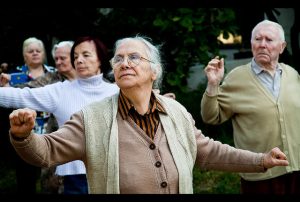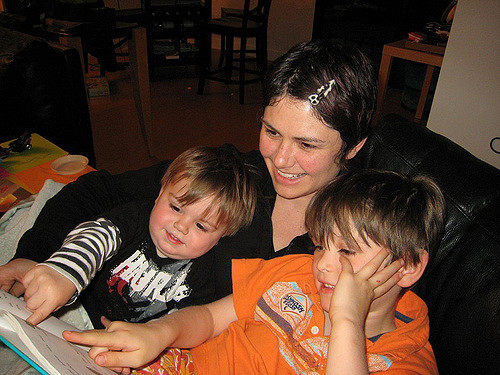Socialization Through the Life Course
Learning Objectives
- List the major changes of the life course.
- Provide an example of how events during childhood may have a lifelong impact.
- Discuss what is meant by resocialization.
- List any two characteristics of a total institution.
As you probably realize by now, most theories and discussions of socialization concern childhood. However, socialization continues throughout the several stages of the life course, most commonly categorized as childhood, adolescence, adulthood, and old age. Within each of these categories, scholars further recognize subcategories, such as early adolescence and late adolescence, early adulthood and middle adulthood, and so forth. This section sketches some important aspects of the major life course stages.
Childhood
Despite increasing recognition of the entire life course, childhood (including infancy) certainly remains the most important stage of most people’s lives for socialization and for the cognitive, emotional, and physiological development that is so crucial during the early years of anyone’s life. We have already discussed what can happen if an infant does not receive “normal” socialization from at least one adult, and feral children are a sad reminder that socialization is necessary to produce an entity that not only looks human but really is human in the larger sense of the word.
Beyond this basic importance of childhood, however, lies an ugly truth. In regard to education, health, and other outcomes, many children do not fare well during childhood. Moreover, how well they do fare often depends on their social location—their social class, their race and ethnicity, and their gender. The Federal Interagency Forum on Child and Family Statistics regularly publishes a report called America’s Children: Key National Indicators of Well-Being (including a shorter version in some years). This report provides an annual update of how children are faring on more than three dozen measures. The Forum’s latest report, published in July 2010, provided some disturbing facts about children’s well-being, and it also showed the difference that social location makes for their well-being (Federal Interagency Forum on Child and Family Statistics, 2010).
In one important finding, only about 55% of children aged 3–5 and not in kindergarten had a family member read to them daily. This figure varied by income level. Only 40% of children in families below the poverty level profited in this way, compared to 64% of children whose families’ incomes were at least twice as high as the poverty level.
About 55% of children aged 3–5 who are not in kindergarten have a family member read to them every day. Social class affects the likelihood of reading to children: only 40% of children in families below the poverty level are read to daily, compared to 64% of children in families with incomes twice the poverty level or higher.
Neeta Lind – IMG_3646 – CC BY 2.0.
In other important findings, about one-fifth of U.S. children lived in poverty in 2008, a figure that rose to more than 30% of African American and Latino children. As well, slightly more than one-fifth of children were in families that sometimes were “food insecure,” meaning they had trouble providing food for at least one family member. More than 40% of households with children in 2007 were characterized by crowded or physically inadequate conditions.
What happens during childhood can have lifelong consequences. Traumatic experiences during childhood—being neglected or abused, witnessing violence, being seriously injured, and so forth—put youngsters at much greater risk for many negative outcomes. They are more likely to commit serious delinquency during adolescence, and, throughout the life course, they are more likely to experience various psychiatric problems, learning disorders, and substance abuse. They are also less likely to graduate high school or attend college, to get married or avoid divorce if they do marry, and to gain and keep a job (Adams, 2010). The separate stages of the life course are really not that separate after all.
Adolescence
As many readers may remember, adolescence can be a very challenging time. Teenagers are no longer mere children, but they are not yet full adults. They want their independence, but parents and teachers keep telling them what to do. Peer pressure during adolescence can be enormous, and tobacco, alcohol, and other drug use become a serious problem for many teens.
These are all social aspects of adolescence, but adolescence also is a time of great biological change—namely, puberty. Puberty obviously has noticeable physiological consequences and, for many adolescents, at least one very important behavioral consequence—sexual activity. But early puberty also seems to have two additional effects: among both boys and girls, it increases the likelihood of delinquency and also the likelihood of becoming a victim of violence (Schreck, Burek, Stewart, & Miller, 2007). These twin consequences are thought to happen for at least two reasons. First, early puberty leads to stress, and stress leads to antisocial behavior (which can also result in violence against the teen committing the behavior). Second, teens experiencing early puberty (early maturers) are more likely to hang out with older teens, who tend to be more delinquent because they are older. Because their influence “rubs off,” early maturers get into trouble more often and are again more likely to also become victims of violence.
Romantic relationships, including the desire to be in such a relationship, also matter greatly during adolescence. Wishful thinking, unrequited love, and broken hearts are common. Dating multiple partners is thought to contribute to delinquency and substance abuse, in part because dating occurs at parties and in other unsupervised settings where delinquency and drug use can occur, and in part because the emotional problems sometimes accompanying dating may result in delinquency, drug use, or both (Seffrin, Giordano, Manning, & Longmore, 2009).
As the discussion on childhood suggested, social class, race and ethnicity, and gender continue to affect the experiences of individuals during adolescence. Adolescence can certainly be an interesting stage of the life course, but how we fare during adolescence is often heavily influenced by these three fundamental aspects of our social location.
Emerging Adulthood
2008 was a year of financial upheaval in the United States. Rampant foreclosures and bank failures set off a chain of events sparking government distrust, loan defaults, and large-scale unemployment. How has this affected the United States’s young adults?

Creative Commons 2.0
Millennials, sometimes also called Gen Y, is a term that describes the generation born during the early eighties to early nineties. While the recession was in full swing, many were in the process of entering, attending, or graduating from high school and college. With employment prospects at historical lows, large numbers of graduates were unable to find work, sometimes moving back in with their parents and struggling to pay back student loans.
According to the New York Times, this economic stall is causing the Millennials to postpone what most Americans consider to be adulthood: “The traditional cycle seems to have gone off course, as young people remain untethered to romantic partners or to permanent homes, going back to school for lack of better options, traveling, avoiding commitments, competing ferociously for unpaid internships or temporary (and often grueling) Teach for America jobs, forestalling the beginning of adult life” (Henig 2010). The term Boomerang Generation describes recent college graduates, for whom lack of adequate employment upon college graduation often leads to a return to the parental home (Davidson, 2014).
Emerging adulthood, as exemplified by the experience of many Millennials, is a relatively recent phase of the life span located between the adolescence and full-fledged adulthood. The term describes young adults who do not have children, do not live in their own home, or do not have sufficient income to become fully independent. Jeffrey Arnett (2000) suggests emerging adulthood is the distinct period between 18 and 25 years of age where adolescents become more independent and explore various life possibilities. Arnett argues that this developmental period can be isolated from adolescence and young adulthood. Emerging adulthood is proposed as a new developmental stage centered on “identity exploration, instability, self-focus, and feeling in-between”. Arnett called this period “roleless role” because emerging adults do a wide variety of activities, but are not constrained by any sort of “role requirements”.
The five milestones that define adulthood, Henig writes, are “completing school, leaving home, becoming financially independent, marrying, and having a child” (Henig 2010). These social milestones are taking longer for Millennials to attain, if they’re attained at all. Sociologists wonder what long-term impact this generation’s situation may have on society as a whole.
Adulthood
Adulthood is usually defined as the 18–64 age span. Obviously, 18-year-olds are very different from 64-year-olds, which is why scholars often distinguish young adults from middle-age adults. In a way, many young adults, including most readers of this book, delay entrance into “full” adulthood by going to college after high school and, for some, then continuing to be a student in graduate or professional school. By the time the latter obtain their advanced degree, many are well into their 30s, and they finally enter the labor force full time perhaps a dozen years after people who graduate high school but do not go on to college. These latter individuals may well marry, have children, or both by the time they are 18 or 19, while those who go to college and especially those who get an advanced degree may wait until their late 20s or early to mid-30s to take these significant steps.
Marriage and parenthood are “turning points” in many young adults’ lives that help them to become more settled and to behave better than they might have behaved during adolescence.
Blaise Alleyne – Husband and Wife exit the Church – CC BY-SA 2.0.
One thing is clear from studies of young adulthood: people begin to “settle down” as they leave their teenage years, and their behavior generally improves. At least two reasons account for this improvement. First, as scientists are increasingly recognizing, the teenaged brain is not yet fully mature physiologically. For example, the frontal lobe, the region of the brain that governs reasoning and the ability to consider the consequences of one’s actions, is not yet fully formed, leaving teenagers more impulsive. As the brain matures into the mid- and late 20s, impulsiveness declines and behavior improves (Ruder, 2008).
Second, as sociologists recognize, young adulthood is a time when people’s “stakes” in society and conformity become stronger. Many get married, some have children, and most obtain their first full-time job. These “turning points,” as they are called, instill a sense of responsibility and also increase the costs of misbehavior. If you are married, your spouse might not be very happy to have you go barhopping every weekend night or even more often; if you are employed full time, your employer might not be very happy to have you show up hung over. Marriage and employment as turning points thus help account for the general improvement in behavior that occurs after people reach adulthood (Laub, Sampson, & Sweeten, 2006).
Social class, race and ethnicity, and gender continue to affect how people fare during adulthood. Chapter 8 “Social Stratification” through Chapter 11 “Gender and Gender Inequality” and sections in some subsequent chapters discuss this important but discouraging fact of our social world.
Old Age

This stage of the life course unofficially begins at age 65. Once again, scholars make finer distinctions—such as “young-old” and “old-old”—because of the many differences between people who are 65 or 66 and those who are 85, 86, or even older. Chapter 12 “Aging and the Elderly” is devoted entirely to this period of the life course. Here we will just indicate that old age can be a fulfilling time of life for some people but one filled with anxiety and problems for other people, with social location (social class, race and ethnicity, and gender) once again often making a considerable difference. These problems are compounded by the negative views and even prejudice that many Americans have toward old age and toward people who are old. Because we all want to be old someday, the discussion of aging and the elderly in Chapter 12 “Aging and the Elderly” should be of special interest.
Resocialization and Total Institutions
Some people live in settings where their lives are so controlled that their values and beliefs change drastically. This change is so drastic, in fact, that these people are in effect resocialized. Such resocialization occurs in what Erving Goffman (1961) called total institutions. As their name implies, these institutions have total control over the lives of the people who live in them.
A boot camp is an example of a total institution.
dualdflipflop – Marine Corps Boot Camp – CC BY-ND 2.0.
Several types of total institutions exist: mental asylums, Nazi concentration camps, military boot camps, convents, and monasteries. Some scholars would also say that criminal prisons are total institutions, as they exhibit some of the same processes found in the other types. As this list implies, total institutions can be used for good or bad purposes, and so can resocialization.
Whether we are talking about total institutions that are good or bad, they all share certain processes and procedures that make them total institutions. The most important characteristic is that they have total control over the lives of their inmates, patients, or whatever the people who live in them are called. These residents, to use a generic term, have no freedom or autonomy. They are told what to do and when to do it, and punishment for rule infraction can be quite severe. In Nazi concentration camps, punishment was torture or death; in religious cloisters, it may be banishment; in boot camp, it may be a court-martial; in mental asylums, it may be solitary confinement in a straitjacket.
Second, total institutions take away the identity of their residents in an effort to weaken their self-identity and ensure conformity to the institutions’ rules. Their residents typically wear uniforms and often have their heads shaved and, depending on the institution, may be known by a number or a new name. These procedures make everyone look more similar to each other than they otherwise would and help weaken the residents’ self-identity. Whether these outcomes are good or bad depends again on which total institution we have in mind.
Third, total institutions subject their residents to harsh treatment and, quite often, abuse, although the nature of this abuse, and whether it occurs at all, obviously depends on which total institution we have in mind. Nazis starved concentration camp inmates, tortured them, stripped them naked, conducted hideous experiments on them, and, of course, exterminated millions (Gigliotti & Lang, 2005). Literature on mental asylums is filled with examples of abuses of the patients living there (Goffman, 1961). Drill sergeants have also been known for harshly treating new recruits: some observers defend this practice as necessary for military discipline and readiness, while others consider it to be unjustified abuse.
Resocialization is often accompanied via a degradation ceremony, an encounter in which a total institution’s resident is humiliated, often in front of the institution’s other residents or officials (Goffman, 1961). A drill sergeant may call a physically unconditioned male recruit a “girl” or “lady” and question his manhood in front of other recruits. In a mental asylum or prison, an inmate may be stripped naked and checked in their private areas for lice and other vermin. Shaving the heads of new military recruits or prison inmates is another example of a degradation ceremony.
Resocialization also occurs in groups that are not in institutional settings. Alcoholics Anonymous is one such group, as it tries to change the alcoholics’ value system by having them internalize several principles about how to live one’s life. The goal here, of course, is to have the alcoholic stop drinking and to continue to refrain from drinking (Davis & Jansen, 1998). Some religious cults also resocialize their members and continue to spark much controversy in today’s society (Cowan & Bromley, 2008).
Socialization and Social Change
This chapter began with a news story about the beating and killing of a gay man and proceeded with the stories of two women who grew up in the South when it was racially segregated. These stories illustrate the power of socialization, which can have both good and bad consequences. Socialization into one’s culture is necessary for any society to exist, and socialization is also necessary for any one individual to be “human” in the social sense of the term, as our discussion of feral children indicated. Yet socialization can also result in attitudes and behaviors that most of us would rightly condemn. Socialization created the homophobic mentality that led three teenagers to beat Charlie Howard and throw him into a river, and it also created the racist mentality that Sarah Patton Boyle and Lillian Smith described in their accounts of growing up in the South. Most of us are socialized to become good, cooperative members of society, but some of us are socialized to hold very negative views of certain groups in society.
For many of the social issues confronting the United States today—hate crimes, other crimes, violence against women, sexism, racism, and so forth—it might not be an exaggeration to say that new patterns of socialization are ultimately necessary if our society wants to be able to address these issues effectively. Parents of young children and adolescents bear a major responsibility for making sure our children do not learn to hate and commit harm to others, but so do our schools, mass media, and religious bodies. No nation is perfect, but nations like Japan have long been more successful than the United States in raising their children to be generous and cooperative. Their examples hold many good lessons for the United States.
Key Takeaways
- The four stages of the life course are childhood, adolescence, adulthood, and old age. Socialization continues throughout all these stages.
- What happens during childhood may have lifelong consequences. Traumatic experiences and other negative events during childhood may impair psychological well-being in adolescence and beyond and lead to various behavioral problems.
- Social location in society—social class, race and ethnicity, and gender—affects how well people fare during the stages of the life course.
- Resocialization involves far-reaching changes in an individual’s values, beliefs, and behavior.
- Total institutions exert total control over the lives of their residents. They typically try to eliminate the individual identity of their residents and often subject them to harsh treatment.
- New socialization practices might be necessary to address many of the social ills facing the United States and other societies.
Self Check
References
Adams, E. J. (2010). Healing invisible wounds: Why investing in trauma-informed care for children makes sense. Washington, DC: Justice Policy Institute.
America’s children in brief: Key national indicators of well-being, 2010. Washington, DC: U.S. Government Printing Office.
Arnett, Jeffrey (2000). Emerging Adulthood: A Theory of Development from the late teens through the twenties”. American Psychologist 55 (5): 469-480.
Davidson, Adam. 2014. “It’s Official, the Boomerang Kids Won’t Leave.” New York Times, June 20. Retrieved October 27, 2014 (http://www.nytimes.com/2014/06/22/magazine/its-official-the-boomerang-kids-wont-leave.html?_r=0).
Henig, Robin Marantz. 2010. “What Is It About Twenty-Somethings?” New York Times, August 18. Retrieved December 28, 2011 (http://www.nytimes.com/2010/08/22/magazine/22Adulthood-t.html?adxnnl=1&adxnnlx=1325202682-VVzEPjqlYdkfmWonoE3Spg).
Laub, J. H., Sampson, R. J., & Sweeten, G. A. (2006). Assessing Sampson and Laub’s life-course theory of crime. In F. T. Cullen (Ed.), Taking stock: The status of criminological theory (vol. 15, pp. 313–333). New Brunswick, NJ: Transaction.
Ruder, D. B. (2008). The teen brain: A work in progress. Harvard Magazine, 111(1), 8–10.
Schreck, C. J., Burek, M. W., Stewart, E. A., & Miller, J. M. (2007). Distress and violent victimization among young adolescents. Journal of Research in Crime & Delinquency, 44(4), 381–405.
Seffrin, P. M., Giordano, P. C., Manning, W. D., & Longmore, M. A. (2009). The influence of dating relationships on friendship networks, identity development, and delinquency. Justice Quarterly, 26(2), 238–267.




